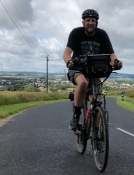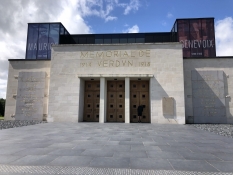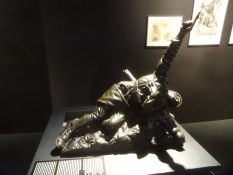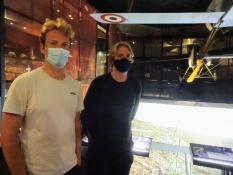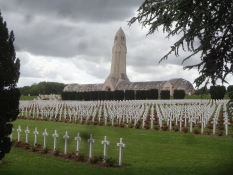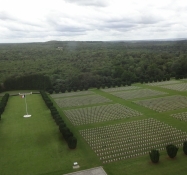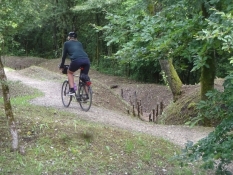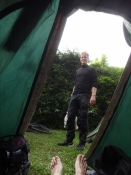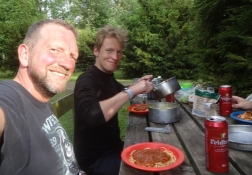Radtour Radurlaub entlang der Maas
Dag/day 3: Verdun
![]()
Bitte warten - Kartendaten werden geladen
Erstellt am 15.07.2021
zuletzt geändert von Ottocolor am 16.09.2021
Strecken-Merkmale
gefahren
Gesamtlänge in km
27
Gesamthöhenmeter Aufstieg
327
Durchschn. Steigung Aufstieg %
1,21
Gesamthöhenmeter Abstieg
331
min. Höhe
187
max. Höhe
376
Informationen zu Rechten an den GPS-Track-Daten | |
|---|---|
Rechte-Inhaber | |
Rechte-Ausprägung / Lizenz | cc0: Public Domain keine Rechte vorbehalten |
Link zur Rechtebeschreibung | |
gpx-Datei hochgeladen | durch Ottocolor am 15.07.2021
|
Gesamtzahl Trackpoints
478
Trackpoint-Dichte per km
18
Endorte
Start
Verdun, Grand Est, FR (194 m NHN)
Ziel
Verdun, Grand Est, FR (190 m NHN)
gefahren am
06.07.2021
Wetter
At night and in the morning a heavy downpour, but during the day dry weather. Overcast, but in the evening some sunny spells. Somewhat cooler than the previous day and not above 20°C. Light winds.
Beschaffenheit
Safely through Verdun on bike lanes og town roads. Minor roads up to the battlefield places around Douaumont almost without any traffic. Likewise on our tour homebound, where we also managed a gravel path over a hill and a bit exposed to traffic in Belleville and Verdun.
Steigungs-Verteilung
Bemerkungen
The rest day included a steep hill, but without luggage, as we had left it on the camp site of Les Breuils in the outskirts of Verdun.
Reisebericht
As always I was the one first out of the tent, even if I had slept badly the last hours because of a heavy downpour in the early-early morning. And campsite daddy asked me considerately if everything was okay, when I shopped for baguettes and croissants. As I understood from him the rain had drenched some of the other tent people. Alexander and Simon had also lay awake for some time, but neither of them had experienced water inside the tent, so we were ready to enjoy our rest day, as soon as we had had breakfast, made sandwiches for lunch, done the dishes and attended to our morning toilette. The latter I managed in rather high spirits, as we were to visit the battlefield, which constitutes THE symbol of WWI's madness in particular and the madness of war in a whole.
We chose to cycle to the battlefield site itself, which is situated in the hills 7 or 8 km northeast of the town of Verdun. Down here no real fighting took place, as the Germans never conquered the Verdun fortress itself. It was considered very strong, but really not strategically important. The Germans could have gone past it, which they patently had done, when they took the St. Mihiel salient some 70 km to the south almost two years, before the German Army High Command and general Falkenhayn decided to concentrate all power on an attack against Verdun, knowing that the fortress was very hard to take. Its fortification was added massively by a ring of forts in the low mountains. The German idea was that if Verdun fell, French morale would have suffered that much that the road to Paris lay open. Falkenhayn also reckoned that France would loose Britain as an ally, because she in this case would consider any resistance as hopeless. On the contrary, the French knew that they had to hold Verdun at any cost. Did they succeed in this, French fighting morale would stay strong. And they did, as a matter of fact. How they did that and at which cost and what the Germans did to penetrate their defense was the subject we had set out to learn about today. Consequently, we trode our bikes, suddenly eased of their burden of the heavy panniers and bags, uphill into the battlefield area.
Informationen zu Urheber-Rechten | |
|---|---|
Rechte-Ausprägung / Lizenz | by-sa: CREATIVE COMMONS Namensnennung, Weitergabe unter gleichen Bedingungen |
Link zur Rechtebeschreibung | |
übernommen / bearbeitet am | 04.09.2021
|
übernommen / bearbeitet durch |
|
Informationen zu Urheber-Rechten | |
|---|---|
Rechte-Inhaber | |
Rechte-Ausprägung / Lizenz | by-sa: CREATIVE COMMONS Namensnennung, Weitergabe unter gleichen Bedingungen |
Link zur Rechtebeschreibung | |
Bild hochgeladen | durch Ottocolor am 20.07.2021
|
Informationen zu Urheber-Rechten | |
|---|---|
Rechte-Inhaber | |
Rechte-Ausprägung / Lizenz | by-sa: CREATIVE COMMONS Namensnennung, Weitergabe unter gleichen Bedingungen |
Link zur Rechtebeschreibung | |
Bild hochgeladen | durch Ottocolor am 20.07.2021
|
Informationen zu Urheber-Rechten | |
|---|---|
Rechte-Inhaber | |
Rechte-Ausprägung / Lizenz | by-sa: CREATIVE COMMONS Namensnennung, Weitergabe unter gleichen Bedingungen |
Link zur Rechtebeschreibung | |
Bild hochgeladen | durch Ottocolor am 20.07.2021
|
Before climbing the heights we cycled past Verdun's fortress and through the town centre, which lies neatly down to the river Meuse and its companion for most of its course, the ship canal. We passed the cathedral, as Verdun is also an old episcopal residence. The old Bishop's palace is now home to the Museum of Peace. Very appropriate in a town so much known for the opposite. We agreed upon trying to make a visit there tomorrow morning, before we ventured out on the stage to Inor. This would make the contrast perfect, but today the theme was war for the three of us. Consequently, I was dressed in my Finnish winter war t-shirt. In that my chest is decorated by a skull, depicting a dead Russian soldier, who died the so-called "white death". In the winter of 1939 to 40 the Finns played the French role as defenders of the fatherland and the Russians, consequently, the Germans'. Today the horrors of war are, thank God, long reconciled on both sides, however, as we were going to witness, they are not forgotten. And they never must! The reconciliation spoke out of a sign at the road out of Verdun. It said in German: "Wir danken für Ihren Besuch." "Thank you for your visit." They didn't say that in 1916. Then they said: "Ils non pas passé" - "They did not pass".
The first memorial we passed was in honour of André Maginot. He's known for the Maginot line, the French defence line towards Germany, which he as French minister of defence erected in the 1930's. But, alas, as in the previous World War the Germans attacked mainly through Belgium and thus bypassed the Maginot line.
We also saw a memorial in honour of the French supreme commander in WWI and the great hero of the battle of Verdun Marshall Pétain. He became known for a relatively humane attitude towards his soldiers, who were granted the necessary rest behind the lines in between the periods at the front. Unfortunately for him, under WWII he was senteced to death as a traitor to his country as the leader of the German-friendly unoccupied part of France known as Vichy France. His successor as commander in chief Nivelle, who had the French command in the last part of the battle of Verdun, lasting almost ten months, was a lot more ruthless in executing his tactics, and consequently the losses rose dramatically.
It was scary thinking about that where we now rode our bicycles through peaceful forest, death had reigned in a hell of artillery granades, infantry attacks, dirt, thirst and, yes, death. A sign said Fleury-devant-Douaumont. This was one of the villages up here that were so totally destroyed and its inhabitants either were killed or had fled that they were never rebuilt. But a chapel had been built on the place, we saw.
We were now heading for Fort Douaumont, one of the most heavily fought forts of the fortress ring around Verdun. But before that we went into the museum, commemorating the battle of Verdun from February to November 1916. It looked massively from the outside, and inside every modern appliance is used to make the experience real and touching. And so it was. We all three got deeply moved by this callous murdering on both sides. I appreciated that the exhibition showed that the murdering took place on both sides. As it were the French defending their country against an aggressor, one might have expected some glorification of the defenders, but I didn't feel that. The death toll after the ten month of fighting was indeed almost as big on either side, about 350,000 dead and incredibly more wounded, mutilated and missing.
We stayed inside for quite a long time, and outside we found our bikes and had lunch at the roadside. But we had also plans of visiting the ossuary and the fort of Douaumont, so we rode all the way up to the top of the hill.
Informationen zu Urheber-Rechten | |
|---|---|
Rechte-Ausprägung / Lizenz | by-sa: CREATIVE COMMONS Namensnennung, Weitergabe unter gleichen Bedingungen |
Link zur Rechtebeschreibung | |
übernommen / bearbeitet am | 04.09.2021 - 07.09.2021
|
übernommen / bearbeitet durch |
|
Informationen zu Urheber-Rechten | |
|---|---|
Rechte-Inhaber | |
Rechte-Ausprägung / Lizenz | by-sa: CREATIVE COMMONS Namensnennung, Weitergabe unter gleichen Bedingungen |
Link zur Rechtebeschreibung | |
Bild hochgeladen | durch Ottocolor am 20.07.2021
|
Informationen zu Urheber-Rechten | |
|---|---|
Rechte-Inhaber | |
Rechte-Ausprägung / Lizenz | by-sa: CREATIVE COMMONS Namensnennung, Weitergabe unter gleichen Bedingungen |
Link zur Rechtebeschreibung | |
Bild hochgeladen | durch Ottocolor am 20.07.2021
|
Informationen zu Urheber-Rechten | |
|---|---|
Rechte-Inhaber | |
Rechte-Ausprägung / Lizenz | by-sa: CREATIVE COMMONS Namensnennung, Weitergabe unter gleichen Bedingungen |
Link zur Rechtebeschreibung | |
Bild hochgeladen | durch Ottocolor am 20.07.2021
|
Just a few years after the end of World War I it became obvious to many, not the least in France, that the human suffering had been so extreme that it required a very special memorial. And just as obvious it was that it had to be placed in the Verdun area. This way the idea of the ossuary in Douaumont, another of the disused villages, came into being. I think they put it like this: How can we create a memorial that for the world to come shows the consequences of this battle? And this world soon encompassed not only the Verdun battle but war and hostilities between humans in a whole. And quite naturally the new German republic, the Weimar republic, which had succeeded the German Empire, and which had to deal with the enourmous legacy and debt, the material one as well as the moral, did participate in the building of the ossuary. Its basement is resting place of hundred thousands of war victims, who were not buried on the cemetaries of the area, most commonly because they could not be identified. This basement it is possible to look into through small windows. In the ground floor the huge memorial hall is placed with the many names on the walls. A solemn athmosphere reings in here, where the light is subdued, there's silence, and it's forbidden to take photographs. Afterwards we went up the stairs to the memorial's tower, which commands a splendid view. The town of Verdun is not seen, as there are more hills further south, each of which was fortified during the Great War, as World War I often is called in my homeland of Southern Jutland. For many of its inhabitants for many years it was bigger than the following world war, as Southern Jutland was a part of the German Empire until 1920. Consequently, many thousand young men, living here, had to participate in a war they were not part of. 6,000 of them paid the highest price. And there's hardly a church in Southern Jutland without a memorial board telling the names of the victims of the parish during the Great War.
In front of the ossuary lies the enormous cemetary with all its many white crosses. Between it and the ossuary there's a podium where many state and government leaders have stood, lowering their heads. Not the least the French-German reconciliation has been the subject here several times, perhaps never stronger, when French president Francois Mitterand and German chancellor Helmut Kohl stood hand in hand as a gesture of reconciliation in August 1984, 70 years after the start of the war. And the held each others hands for a very long time.
Having left the ossuary, where the numbers of guests had been astonishingly low, we were in need for a nourishing cup of coffee, which we were offered at a deserted café in the middle of nowhere. I was even praised for trying to speak French ordering a café au lait with glace (ice cream) All of it was good for our mood on this rather gloomy day. On our way to the Fort Douaumont, the last sightseeing place of the day, Simon cycled on the path next to the trenches running in this area. That was good for our mood too. In the cold and damp cells of the fort on this warm if overcast summer day it soon rock bottomed again.
Informationen zu Urheber-Rechten | |
|---|---|
Rechte-Ausprägung / Lizenz | by-sa: CREATIVE COMMONS Namensnennung, Weitergabe unter gleichen Bedingungen |
Link zur Rechtebeschreibung | |
übernommen / bearbeitet am | 07.09.2021
|
übernommen / bearbeitet durch |
|
Informationen zu Urheber-Rechten | |
|---|---|
Rechte-Inhaber | |
Rechte-Ausprägung / Lizenz | by-sa: CREATIVE COMMONS Namensnennung, Weitergabe unter gleichen Bedingungen |
Link zur Rechtebeschreibung | |
Bild hochgeladen | durch Ottocolor am 20.07.2021
|
Informationen zu Urheber-Rechten | |
|---|---|
Rechte-Inhaber | |
Rechte-Ausprägung / Lizenz | by-sa: CREATIVE COMMONS Namensnennung, Weitergabe unter gleichen Bedingungen |
Link zur Rechtebeschreibung | |
Bild hochgeladen | durch Ottocolor am 20.07.2021
|
Informationen zu Urheber-Rechten | |
|---|---|
Rechte-Inhaber | |
Rechte-Ausprägung / Lizenz | by-sa: CREATIVE COMMONS Namensnennung, Weitergabe unter gleichen Bedingungen |
Link zur Rechtebeschreibung | |
Bild hochgeladen | durch Ottocolor am 20.07.2021
|
Fort Douaumont was the most heavily battled fort of the Verdun battlefield and became a symbol of the human suffering. We had a tour of its casements and were led by audioguides, including scary noises. As if the stories' content hadn't been terrifying enough. We silently walked about in the cold, raw concrete corridors and casements, thoughtfully listening.
The French public considered the fort a stronghold of the defense of the homeland, so when it fell into the enemy's hands, almost without fighting, already in February 1916, it was rather shocking for them. From a military perspective, however, it was obsolete. This proved true for the Germans during their period of possession. Among German soldiers it was, consequently, nicknamed "Sargdeckel" ("coffin lid"). Well, during the first months of the Verdun battle it was actually the safest place to be in this highly "unhealthy" environment. Perhaps it was this false feeling of safety that led to the huge explosion on June, 8th, 1916, which instantly killed 679 German soldiers. Out of a lack of time they were buried behind a quickly built wall, in front of which, even today, there stands a white cross. The reason for the explosion is still a riddle, but simple uncautiousness with gunpowder and flamethrowers seems to be central.
The fort remained an important stepstone for the German attempt to conquer Verdun, and they did certainly advance and took also fort Vaux, however, fort Souville, just a few kilometres further to the south, they never managed to capture. On the contrary, the fire from this fort killed a large number of German soldiers. The massive concrete roof of fort Douaumont withstood any kind of French artillery throughout all summer and early autumn 1916. It's said that it was hit by 400,000 artillery grenades. Until The French rolled on two extremely heavy howitzers with a caliber of 400 mm (16 inches) on railway carriages in the Meuse valley in end October 1916. 23 of those pierced the concrete roof of fort Douaumont and exploded inside the fort. But the death toll was not too high, as the Germans were already evacuating the fort, which was occupied by the French on the day after.
After our experiences inside the fort we climbed the roof, from where the view up north the Meuse valley was stunning. Now we had had enough of war, death and destruction and wanted to go down to Verdun town, have dinner and relax at the campsite. Luckily, it was mostly downhill, so soon we passed the town sign. My sons offered to cook dinner, so they stopped at a supermarket for shopping, while I relaxed in my tent. And soon after they served a pasta bolognese dish at a table and bench set near our tents. And the sun was out after it had been overcast all day.
After the dishes, which was my job, we enjoyed ourselves on the restaurant terrace with beer and football on a large screen. It grew late, as the Italians needed a penalty shoot out, before they had sent the Spaniards out of the European Cup and had entered the final themselves. Tomorrow the Danes were to try to achieve the same merit versus the English. How we would be able to watch that we still didn't know. But the time fixture of 8 o'clock suited os well, we agreed.
Informationen zu Urheber-Rechten | |
|---|---|
Rechte-Ausprägung / Lizenz | by-sa: CREATIVE COMMONS Namensnennung, Weitergabe unter gleichen Bedingungen |
Link zur Rechtebeschreibung | |
übernommen / bearbeitet am | 16.09.2021
|
übernommen / bearbeitet durch |
|

